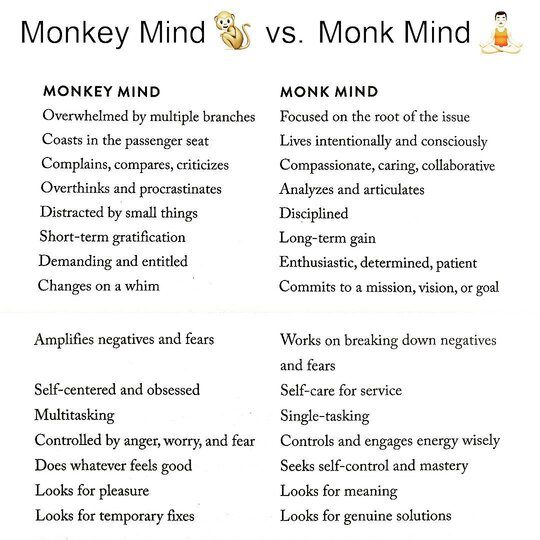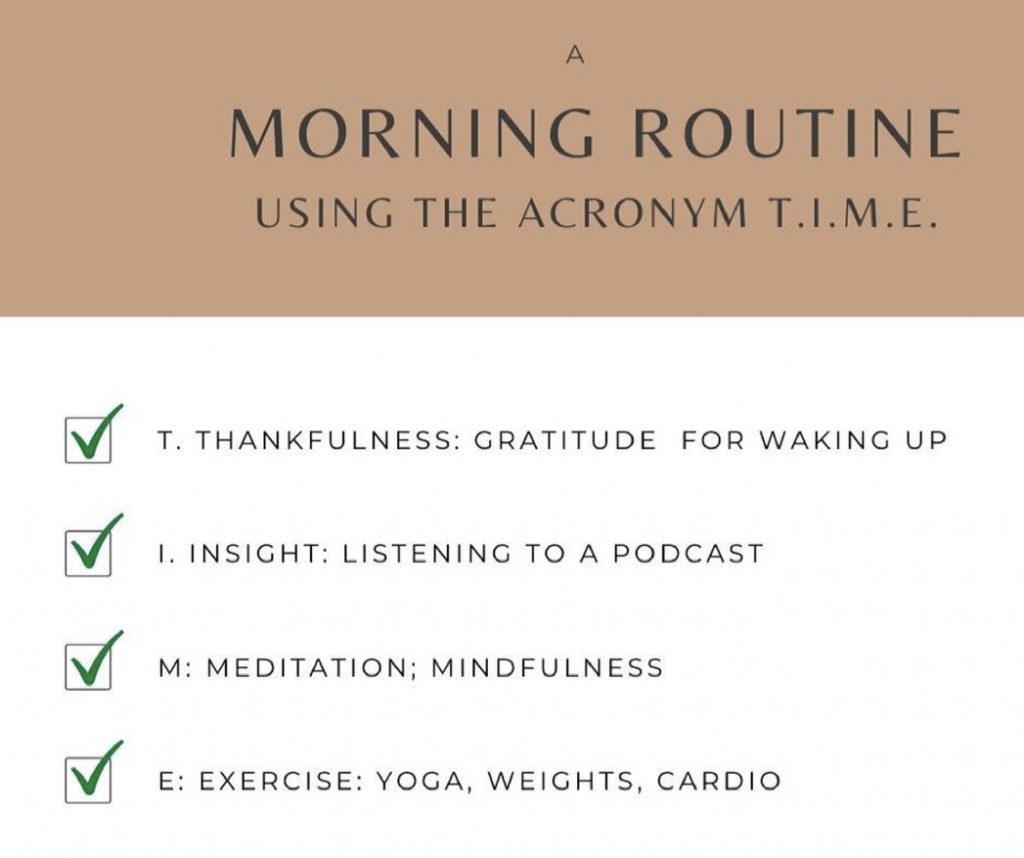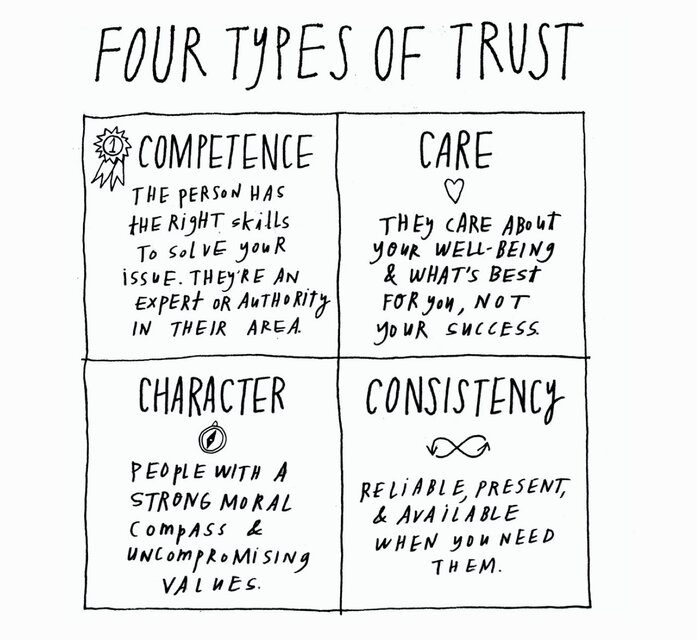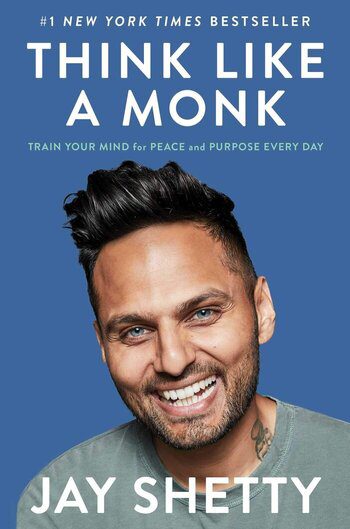Print | Kindle(eBook) | Audiobook
In Think Like a Monk, former monk Jay Shetty writes about the timeless wisdom he learned as a monk into practical steps anyone can take every day to live a less anxious, more meaningful life. Shetty shares great insight and offers advice on reducing stress and improving focus in our very distracted and ever-busy world. The advice Shetty provided is based on his experiences at the Ashram Monastery. He practiced as a monk for three years, and he says that thinking like a monk is not about dressing like a monk but rewiring our habits and thought process.
“Our thoughts are like clouds passing by. The self, like the sun, is always there. We are not our minds.”
Collective Unhappiness
Never before have so many people been so dissatisfied—or so preoccupied with chasing “happiness.” Our culture and media feed us images and concepts about who and what we should be, while holding up models of accomplishment and success. Fame, money, glamour, sex—in the end none of these things can satisfy us. We’ll simply seek more and more, a circuit that leads to frustration, disillusion, dissatisfaction, unhappiness, and exhaustion.
“Yesterday is but a dream. Tomorrow is only a vision. But today well lived makes every yesterday a dream of happiness, and every tomorrow a vision of hope.” – Kālidāsa, the great Sanskrit writer
Monkey vs Monk Mind
Our minds can either elevate us or pull us down. Today we all struggle with overthinking, procrastination, and anxiety as a result of indulging the monkey mind. The monkey mind switches aimlessly from thought to thought, challenge to challenge, without really solving anything. But we can elevate to the monk mindset by digging down to the root of what we want and creating actionable steps for growth. The monk mindset lifts us out of confusion and distraction and helps us find clarity, meaning, and direction.

“the monk way—we go to the root of things, go deep into self-examination. It is only through this curiosity, thought, effort, and revelation that we find our way to peace, calm, and purpose. ”
The Monk Mind
“Thinking like a monk” posits another way of viewing and approaching life. A way of rebellion, detachment, rediscovery, purpose, focus, discipline—and service. The goal of monk thinking is a life free of ego, envy, lust, anxiety, anger, bitterness, baggage. To my mind, adopting the monk mindset isn’t just possible—it’s necessary. We have no other choice. We need to find calm, stillness, and peace.
“When you get stressed—what changes? Your breath. When you get angry—what changes? Your breath. We experience every emotion with the change of the breath. When you learn to navigate and manage your breath, you can navigate any situation in life.”
Method Acting
Unconsciously, we’re all method acting to some degree. We have personas we play online, at work, with friends, and at home. These different personas have their benefits. They enable us to make the money that pays our bills, they help us function in a workplace where we don’t always feel comfortable, they let us maintain relationships with people we don’t really like but need to interact with. But often our identity has so many layers that we lose sight of the real us, if we ever knew who or what that was in the first place. We bring our work role home with us, and we take the role we play with our friends into our romantic life, without any conscious control or intention.
However successfully we play our roles, we end up feeling dissatisfied, depressed, unworthy, and unhappy. The “I” and “me,” small and vulnerable to begin with, get distorted. We try to live up to what we think others think of us, even at the expense of our values.
The voices of parents, friends, education, and media all crowd a young person’s mind, seeding beliefs and values. Society’s definition of a happy life is everybody’s and nobody’s. The only way to build a meaningful life is to filter out that noise and look within. This is the first step to building your monk mind.
Rarely, if ever, do we consciously, intentionally, create our own values. We make life choices using this twice-reflected image of who we might be, without really thinking it through. Cooley called this phenomenon the “Looking-Glass Self.” We live in a perception of a perception of ourselves, and we’ve lost our real selves as a result.
Negativity
Negativity—in conversation, emotions, and actions—often springs from a threat to one of the three needs: a fear that bad things are going to happen (loss of peace), a fear of not being loved (loss of love), or a fear of being disrespected (loss of understanding).
From these fears stem all sorts of other emotions—feeling overwhelmed, insecure, hurt, competitive, needy, and so on. These negative feelings spring out of us as complaints, comparisons, and criticisms, and other negative behaviors. Think of the trolls who dive onto social media, dumping ill will on their targets. Perhaps their fear is that they aren’t respected, and they turn to trolling to feel significant. Or perhaps their political beliefs are generating the fear that their world is unsafe. (Or maybe they’re just trying to build a following—fear certainly doesn’t motivate every troll in the world.)
TYPES OF NEGATIVE PEOPLE
Negative behaviors surround us so constantly that we grow accustomed to them. Think about whether you have any of the following in your life:
- Complainers, like the friend on the phone, who complain endlessly without looking for solutions. Life is a problem that will be hard if not impossible to solve.
- Cancellers, who take a compliment and spin it: “You look good today” becomes “You mean I looked bad yesterday?
- Casualties, who think the world is against them and blame their problems on others.
- Critics, who judge others for either having a different opinion or not having one, for any choices they’ve made that are different from what the critic would have done.
- Commanders, who realize their own limits but pressure others to succeed. They’ll say, “You never have time for me,” even though they’re busy as well.
- Competitors, who compare themselves to others, controlling and manipulating to make themselves or their choices look better. They are in so much pain that they want to bring others down. Often we have to play down our successes around these people because we know they can’t appreciate them.
- Controllers, who monitor and try to direct how their friends or partners spend time, and with whom, and what choices they make.
Austerity of Speech
The Bhagavad Gita refers to the austerity of speech, saying that we should only speak words that are truthful, beneficial to all, pleasing, and that don’t agitate the minds of others. The Vaca Sutta, from early Buddhist scriptures, offers similar wisdom, defining a well-spoken statement as one that is “spoken at the right time. It is spoken in truth. It is spoken affectionately. It is spoken beneficially. It is spoken with a mind of good-will.
FEAR
“Our fears are more numerous than our dangers, and we suffer more in our imagination than reality.” – Seneca
When we track our fears back to their source, most of us find that they’re closely related to attachment—our need to own and control things. We hold on to ideas we have about ourselves, to the material possessions and standard of living that we think define us, to the relationships we want to be one thing even if they are clearly another. That is the monkey mind thinking.
Clinging to temporary things gives them power over us, and they become sources of pain and fear. But when we accept the temporary nature of everything in our lives, we can feel gratitude for the good fortune of getting to borrow them for a time. Even the most permanent of possessions, belonging to the most wealthy and powerful, don’t actually belong to them. This is just as true for the rest of us. And for many—indeed most—of us, that impermanence causes great fear. But, as I learned in the ashram, we can shift our fear to a soaring sense of freedom.
THE FOUR MOTIVATIONS
No matter how disorganized we might be, we all have plans. We have an idea of what we have to accomplish in the day ahead; we probably have a sense of what the year holds, or what we hope we’ll accomplish; and we all have dreams for the future. Something motivates every one of these notions—from needing to pay the rent to wanting to travel the world.
Hindu philosopher Bhaktivinoda Thakura describes four fundamental motivations.
- Fear. Thakura describes this as being driven by “sickness, poverty, fear of hell or fear of death.
- Desire. Seeking personal gratification through success, wealth, and pleasure.
- Duty. Motivated by gratitude, responsibility, and the desire to do the right thing.
- Love. Compelled by care for others and the urge to help them.
These four motivations drive everything we do. We make choices, for example, because we’re scared of losing our job, wanting to win the admiration of our friends, hoping to fulfill our parents’ expectations, or wanting to help others live a better life.
Dharma
Everyone has a psychophysical nature that determines where they flourish and thrive. Dharma is using this natural inclination, the things you’re good at, your thrive mode, to serve others. You should feel the passion when the process is pleasing and your execution is skillful. And the response from others should be positive, showing that your passion has a purpose. This is the magic formula for dharma.
Passion + Expertise + Usefulness = Dharma.
Every morning make some time for:
Thankfulness. Express gratitude to someone, someplace, or something every day. This includes thinking about it, writing it, and sharing it.
Insight. Gain insight through reading the paper or a book, or listening to a podcast.
Meditation. Spend fifteen minutes alone, breathing, visualizing or with sound.
Exercise. You can do yoga as most monk do, but you can do some basic stretches or a workout.

Routine
As late Kobe Bryant told Jay Shetty on his podcast, On Purpose, having a routine is critical to his work.
“A lot of the time, creativity comes from structure. When you have those parameters and structure, then within that you can be creative. If you don’t have structure, you’re just aimlessly doing stuff.” Rules and routines ease our cognitive burden so we have bandwidth for creativity. Structure enhances spontaneity. And discovery reinvigorates the routine.”
Detachment
Detachment is a form of self-control that has infinite benefits across every form of self-awareness and its origin is always in the mind. The Gita defines detachment as doing the right thing for its own sake, because it needs to be done, without worrying about success or failure. That sounds simple enough, but think about what it takes to do the right thing for its own sake. It means detaching from your selfish interest, from being right, from being seen in a certain way, from what you want right now.
“Detaching means escaping the hold of the senses, of earthly desires, of the material world. You have the perspective of an objective observer. Only by detaching can we truly gain control of the mind.“
Solicit Feedback
The monk approach is to look to your guru (your guide), sadhu (other teachers and saintly people), and shastra (scripture). We look for alignment among these three sources. In the modern world many of us don’t have “guides,” and if we do, we probably don’t put them in a different category than teachers. Nor are all of us followers of religious writings. But what the monks are going for here is advice from trusted sources who all want the best for you, but who offer different perspectives.
Choose from those who care most about your emotional health (often friends and family, serving as gurus), those who encourage your intellectual growth and experience (these could be mentors or teachers, serving as sadhus), and those who share your values and intentions (religious guides and/or scientific facts, serving as shastras).
Nobody carries a sign announcing what they have to offer us. Observe people’s intentions and actions.
THE FOUR TYPES OF TRUST
We often expect too much of others when we don’t have a clear sense of their purpose in our lives.
Competence.
Someone has to be competent if we are to trust their opinions and recommendations. This person has the right skills to solve your issue. They are an expert or authority in their area. They have experience, references, and/or a high Yelp rating.
Care.
We need to know a person cares if we are putting our emotions in their hands. Real care means they are thinking about what is best for you, not what is best for them. They care about your well-being, not your success. They have your best interests at heart. They believe in you. They would go beyond the call of duty to support you: helping you move, accompanying you to an important doctor’s appointment, or helping you plan a birthday party or wedding.

Character.
Some people have a strong moral compass and uncompromising values. We look to these people to help us see clearly when we aren’t sure what we want or believe is right. Character is especially critical when we are in an interdependent partnership (a relationship, a business partnership, a team). These people practice what they preach. They have good reputations, strong opinions, and down-to-earth advice. They are trustworthy.
Consistency.
People who are consistent may not be the top experts, have the highest character, or care most deeply for you, but they are reliable, present, and available when you need them. They’ve been with you through highs and lows.
TRY THIS: TWO DEATH MEDITATIONS
To imagine your own death gives you a bird’s-eye view of your life. Try a death meditation whenever you are questioning whether or not to do something—to make a significant change, learn a new skill, take a trip. I recommend that you always do a death meditation at the beginning of a new year, to inspire new paths in the upcoming year.
Visualizing the inevitable will give you every lesson you need to live a fulfilling life. Fast-forward to yourself at age eighty or ninety, however long you want to live, and imagine yourself on your deathbed. Ask your future self questions such as:
- What do I wish I’d done?
- What experiences do I wish I’d had?
- What do I regret not giving more attention?
- What skills do I wish I’d worked on?
- What do I wish I’d detached from?
Use these answers to motivate yourself—instead of having regrets on your deathbed, put those wishes into action today.
Imagine how you’d like to be remembered at your own funeral. Don’t focus on what people thought of you, who loved you, and how sad they will be to lose you. Instead think about the impact you’ve had. Then imagine how you would be remembered if you died today. What’s the gap between these two images? This too should galvanize you to build your legacy.
All the Best in your quest to get Better. Don’t Settle: Live with Passion.



2 Comments
Pingback: Thankfulness, Insight, Meditation and Exercise (TIME). | Lanre Dahunsi
Pingback: Wildly Important Goals. | Lanre Dahunsi